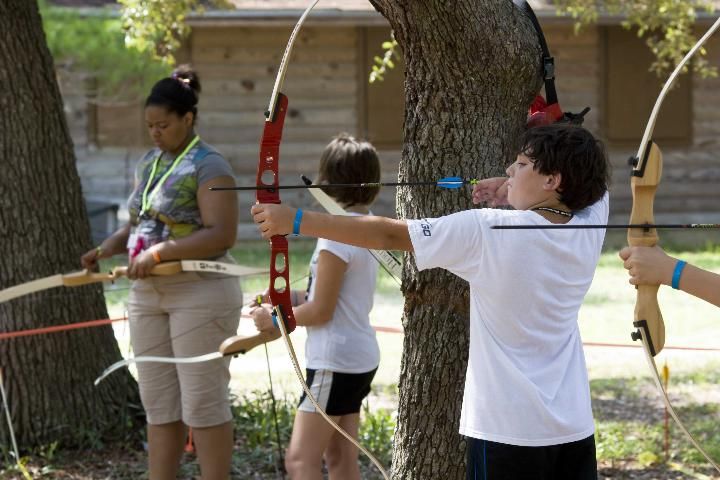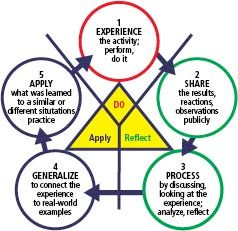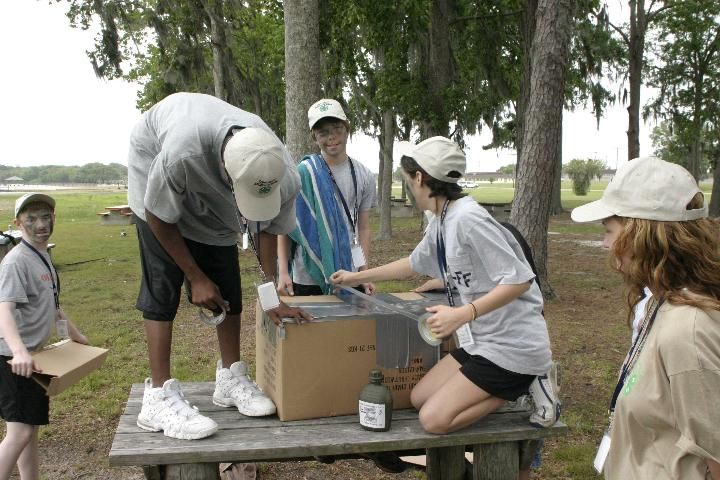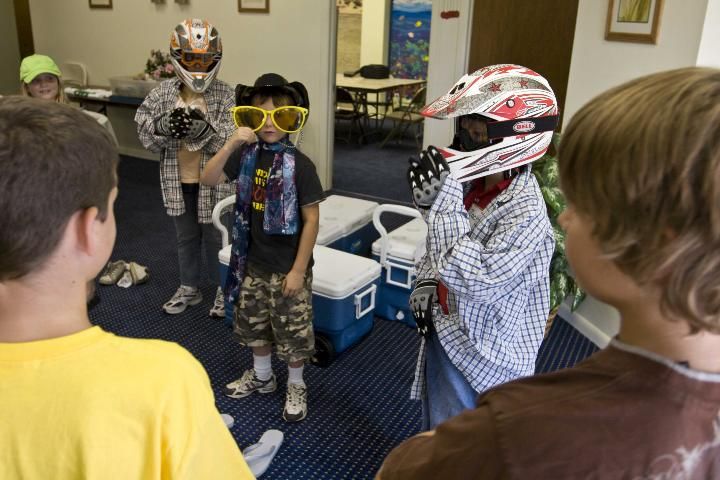
4-H Is Where There's Fun In Learning
As a 4-H volunteer, one of your most important roles is helping youth learn. Especially because membership in 4-H is voluntary, learning in 4-H must be fun. Even if you're not a teacher by profession, you can successfully guide youth to learn communication, leadership, citizenship, and other life skills, as well as subject matter through their 4-H projects and club participation. Sometimes, youth learn better in 4-H than in a formal education setting, and success in 4-H may motivate them to learn better in school. 4-H learning methods and sound curriculum materials are well suited to small groups of youth in a variety of settings, including clubs, camps, schools, home-schooling, and "alternative" learning environments. Using a variety of creative teaching methods is essential for getting the attention of youth and adults. Simply using multiple senses—sight, sound, touch—has been shown to increase learning.
As indicated by the following quote from Seaman A. Knapp (considered the founder of the Extension concept), greater involvement of and participation by learners also helps in retention.
What a person hears, he will probably doubt. What a person sees, he may possibly doubt.
But what a person does for himself, he cannot possibly doubt.
"Learn by doing" has been the core 4-H philosophy behind its approach to teaching youth since its beginning in the early 1900s. Youth are more willing to learn and be attentive when there is something to do, rather than just to listen. However, more is involved in teaching youth than simply using the "learn by doing" approach. "Experiential learning" is a more comprehensive approach, because it encourages youth to think and to discuss with others what they have learned after taking part in a concrete experience. The experiential learning approach allows youth to experience a concept or skill with minimal guidance from an adult. Instead of being told "the answers," they are presented with a question, problem, or activity which they must make sense of for themselves. As a group leader, the adult helps guide youth in a process of doing, sharing, processing, and applying their knowledge in new situations. (Refer to Learn by Doing, + a Little Bit More.) The experiential learning model is also consistent with inquiry learning and the learning cycle used in science education today. A variety of teaching methods are introduced below that can be used in combination with the experiential learning model.

Principles of Teaching and Learning
Learning in 4-H can occur in a variety of settings. Here are some principles to keep in mind that will help you be successful with youth wherever and whenever learning takes place:
- Youth learn best in an atmosphere of warmth and acceptance (belonging).
- Youth want to be actively involved in setting their own goals and in planning their activities (independence).
- Youth have different abilities, they learn at their own rate, and yet they want to be challenged (mastery).
- Youth have knowledge and wisdom to share as well.
- Youth respond to both self-motivation and external motivation.
- Self-evaluation is the most meaningful kind of evaluation.
Preparation
Preparation is important to successful teaching. Keep these points in mind when planning your club activities:
- Know the purpose of the program. What do you want to accomplish?
- Know your audience. What is the size and age range of the group?
- Know the physical set-up. Is the atmosphere conducive to learning? (For example, how are the chairs and tables arranged? Is the lighting adequate?)
- Know what equipment and other materials you will need.
- Be sure the equipment and other materials are all in working order.
- Know the subject you will be teaching. You don't need to be an expert, but you should have resources available.
- Be comfortable. If you are well prepared, you will enjoy teaching young people and will have fun learning along with them!
Other Teaching Methods
The following are descriptions of a variety of methods you can use to help other 4-H'ers learn. You probably already recognize the importance of involving 4-H'ers in ways that will motivate them to learn. Try to vary the teaching methods you use, and engage older youth in helping to teach as well. Not only does this help accommodate different learning styles, it also makes it more interesting for teacher and students!
Educational Games and Simulations
Games can be useful for both fun and learning. They are especially helpful as lead-ins to other activities. There are many types of games available. For example, there are thinking games, action games, board games, and simulations. Also, you can be creative and combine ideas or even invent your own. For instance, a "TV-style game show" can be an entertaining way to learn. If you are working with a group that has a social or recreation director, be sure to involve him or her in suggesting and leading games.
Experiments
A true experiment involves studying the effects of changing one variable while keeping other factors constant. This is a good method for "discovery" learning, where the group proves or disproves its own hypotheses. By breaking up participants into several groups, different variables can be altered simultaneously in order to collect evidence necessary to make conclusions.
Field Trip or Tour
Instead of just talking about a topic, take your group to where it's actually happening! Plan ahead to arrange the location, transportation, and adequate supervision. Also, help youth to be ready with questions, cameras, and other pre-trip preparations.
If you're creative, you may also be able to simulate a tour experience without actually leaving home—by effectively bringing the "field" to your location with video recordings, artifacts, and other elements from the "field." A guest speaker can add to this method. Be sure to brief the speaker about the topic you want presented, as well as the ages and interests of your group, and encourage the speaker to engage the youth in "learn by doing plus a little more." (Refer to Conducting a Successful Field Trip.)

Identification/Matching
This method is good as an introductory activity or as a pre-test/post-test to see how much the group learned. It can be done as a written "test" or as an activity using real objects. Examples: tool identification, matching correct tool for each job, matching photos with names.
Skill-a-thons
Youth rotate from learning station to learning station (usually there are 6–12), where a planned hands-on activity is held over 10–15 minutes. Usually a skill-a-thon is where youth are presented with a task that they work on without directions. Sometimes skill-a-thons introduce a topic, and then you as the leader can observe how well youth perform so that you know what kinds of activities they need to learn next. Or a skill-a-thon can be a final evaluation of skills learned. After youth participate, the leader engages them in sharing and processing the experience.
Role-Playing
A small group of participants acts out a real-life situation in front of the entire group. There is no script. The participants make up their parts as they act. The performance is then discussed in relation to the situation or problem under consideration. Both the performers and spectators get to share their feelings and reactions to the role play.
Skits
A skit is a brief, rehearsed dramatic presentation involving two or more people. Working from a prepared script, the participants act out an event or situation, which is often taken from a real-life experience.
Collage/Bulletin Board/Graffiti Mural
An artistic composition of fragments of printed matter or other materials pasted/fastened to a surface, a collage can be used to convey an idea or theme to others. It can be created by a group or an individual. Materials that might be used include magazine and newspaper clippings, tissue paper, and construction paper. Related methods include a group scrapbook, a bulletin board, or a graffiti mural where participants write their comments, suggestions, and feelings.
Group Discussion and Questioning
This method helps members express their own thoughts. Use open-ended questions to encourage all members to share more information. Open-ended questions usually begin with "how," "what," or "why." The Reflect (Share and Process) and Apply (Generalize and Apply) steps of the 4-H experiential learning model rely on such open-ended questions. This technique can improve all other learning methods, including lectures or illustrated presentations, by inviting more audience participation.
Debate
A debate is a good technique to bring out two sides of an issue. Therefore, it can create sensitivity to, understanding of, and empathy for opposing viewpoints. Examples of debatable issues: advantages and disadvantages of the two-party political system, animal rights.
Brainstorming
This is a way for learners to suggest numerous ideas related to a topic. Spontaneity is essential. All ideas are written down by a recorder. Initially, creative thinking is more important than practical thinking. Therefore, an accepting environment must be provided so all participants feel welcome to contribute. Only after a certain time, when all ideas have been recorded, does the group review the list and determine the most promising idea(s) to pursue to solve the problem at hand.
Buzz Session
A buzz session is a type of brainstorming. The audience is divided into small discussion groups (3–5 members each). All members are involved in the discussion. After a limited time (about five minutes), the small groups might each report back to the total group with a summary of the main points of their discussions. Just about any topic can be discussed using this method (one per session, of course).
Demonstrations
There are two types: method and end result. The method demonstration is a step-by-step procedure showing the process by which something is created. This type may be quite time-consuming. That is why the end-result demonstration is often used. It shows a completed product and reviews the steps taken to achieve this end result. A combination of these two types is commonly used: the demonstrator goes through each step of the process but also has a pre-completed product ready to show. Visual aids are often used.
Presentations
The use of visual aids—such as charts, posters, slides, photos, models, and photos—can significantly enliven a presentation. This allows the audience to use more of their senses, which attracts their interest and enables them to learn more. Computerized multimedia presentations can be stunning, and offer maximum flexibility to make timely changes and to customize content and style to varying audience needs.

Guest Speaker/Panels
Bringing in outside experts can add credibility and objectivity to an educational program. Whereas a guest speaker might only be a talk by a single person, a panel discussion involves a dialogue among a group of four to eight experts on an assigned topic in front of your group. A moderator ensures that order is maintained, each resource person gets equal time, and the topic is covered in depth. When inviting outside speakers, be sure to give them the objectives of the program, the purposes of their participation, the roles you would like them to serve, and any helpful background information (e.g., the local environment, program participants). It may also be beneficial to prepare the audience by inviting participants to study the topic and the professional expertise of the presenters.
Lecture
A lecture is the imparting of information by a presenter who relies mostly on speaking. It tends to be overused. In general, you are discouraged from using this method with 4-H youth. Although it is very efficient at delivering information, it is often boring and therefore not likely to be a very effective instructional method for youth, especially young children. Gifted orators can, however, deliver formal speeches that are captivating and meaningful to teens and adults. The use of gestures, eye contact, relevant stories and anecdotes, dramatic pauses, and varying voice tone and volume are helpful ways to enliven such formal talks. Consider using one concept to talk about as a "lecturette," and spend no more than 10 minutes on it.

Choosing a Teaching Method
The preceding list of teaching methods is certainly not complete. Feel free to use others or a combination of those listed. Here are some points to consider in choosing a method to use:
- Purpose of program
- Number of participants/space available
- Age(s) and interests of participants
- Equipment, materials, assistance, funds available
- Time available
To Help Ensure the Success of Your Teaching Efforts, Don't Forget the Following
- Be prepared by planning ahead. Lack of useful content or logical organization cannot be overcome by creative teaching methods.
- Each method has advantages and disadvantages. Choose methods that are appropriate for the audience and program content.
- Practice! Get comfortable with different methods, especially ones you're not as familiar or comfortable with. Experiment! Improvise! Combine methods! Making teaching fun will make learning fun!
- Involve group members, especially officers, in both planning and delivery when possible. Be sure your club knows what you expect of them. Get as many participants as possible involved in the learning activity.
- Use an action-oriented, learning-by-doing approach as much as possible. Refer to the 4-H experiential learning model for guidance. Processing the experience is when much of the learning takes place. Discussing the activity helps members understand how it relates to them.
Summary
These teaching methods allow you to help members learn in a variety of ways. As you teach members both project and life skills, remember the following hints:
- Catch the interest of the members.
- Focus their attention on the subject.
- Establish a rapport with the group. You don't have to be a buddy, but you need to have mutual respect. It is fine to admit you don't know the answer and for you to learn along with them!
- Recognize and reward positive behaviors of participants. (Refer to Positive Discipline for Children.)
- Be enthusiastic and have a sense of humor! It's contagious. Have fun!
References
Diem, K.G. (1998). Enliven teaching and learning with a variety of instructional methods. Fact Sheet FS892. Rutgers Cooperative Extension, New Brunswick, NJ. https://njaes.rutgers.edu/pubs/publication.php?pid=FS892.
Levings, J. M. (2013). Learn by Doing + a Little More. Florida 4-H Volunteer Leader Series.
Georgia 4-H Volunteer Staff Development Task Force. Georgia 4-H Teaching Techniques. Athens, Georgia.
Pfieffer, J.W. & Jones, J.E. (1985). The Reference Guide to Handbooks and Annuals, Vl. 1-10, 1972-1985. Sand Diego, CA: University Associates.
Powell, G. (1994). Helping 4-H'ers Learn. NJ 4-H Leader Training Series. Rutgers Cooperative Extension, New Brunswick, NJ.
Rennekamp, R. Improving Teaching Effectiveness: A Guide for 4-H Volunteers. State 4-H Office, Lexington, Kentucky.
Experiential Model Long Description
The image is a diagram illustrating a cyclical learning process. In the center is a yellow triangle, with lines dividing it into three sections and extending outward, with "DO" in red text at the top, "Reflect" on the right in green text, and "Apply" on the left in black text. Around the triangle are five circles, each connected by an arrow pointing clockwise to the next circle. At the top center (in the DO section) inside a red circle, is the text "1 EXPERIENCE. the activity; perform, do it." The arrow from it crosses the line extending from the triangle into the "Reflect" part of the cycle, which includes two green circles: 2 SHARE the results, reactions, observations publicly; and 3 PROCESS by discussing, looking at the experience; analyze, reflect. The two remaining circles are in the "Apply" part of the cycle, these are: 4 GENERALIZE to connect the experience to real-world examples; and 5 APPLY what was learned to a similar or different situations practice. The arrow from circle 5 points to circle 1.